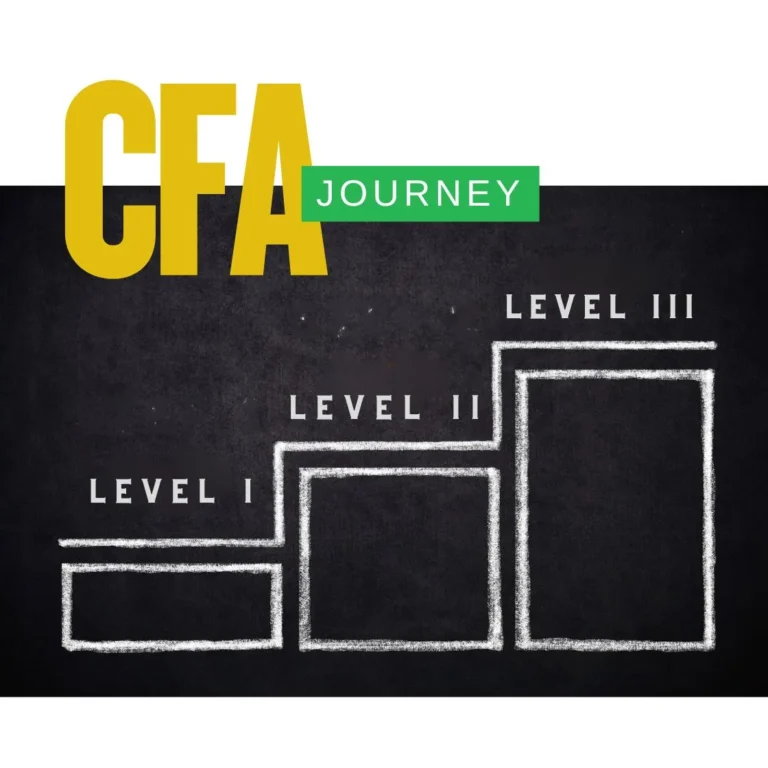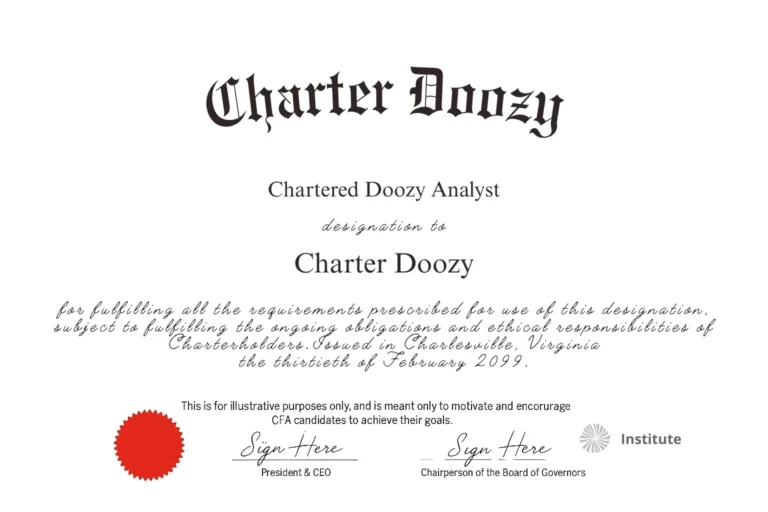Embracing the CFA Journey
Becoming a CFA Charterholder is more than simply passing exams.
It’s a transformative journey.
Each level of the CFA Program builds incrementally, layering knowledge, concepts, and analytical skills.
From foundational understanding at Level I to advanced integration and practical application at Level III.

The Importance of Progressive Learning
It’s crucial to recognize this progression.
The CFA exams are meticulously designed to transition candidates smoothly from novices to highly skilled investment professionals.
Every topic you encounter (be it Ethical Standards, Quantitative Methods, Economics, or Portfolio Management) carefully escalates in complexity.
This ensures your foundational knowledge is solid before moving on to advanced analysis and strategic application.

Why Shortcuts Don’t Work
Taking shortcuts may seem appealing initially.
Especially under the pressure of time constraints or exam stress.
However, skipping fundamental concepts or rushing through critical analytical methods can severely impact your ability to grasp more complex topics at later levels.
Inevitably, any shortcuts taken early on will resurface as challenges down the line.
This can lead to frustration and potentially massive setbacks.

Mastering Each Step
Instead, approach your CFA studies methodically and intentionally.
I know it’s a cliché but still worth repeating – Embrace the journey itself.
Master each concept thoroughly before progressing to the next.
This approach not only ensures you build a robust and lasting knowledge base but also makes your study experience richer and more fulfilling.

Enjoying the Process
Remember, the CFA journey is not just about reaching the destination (~although it about that too).
It’s important to appreciate the transformation along the way.
By focusing on incremental mastery and enjoying the learning process, you will avoid frustration.
You’ll also enhance your readiness for the professional challenges that await as a CFA Charterholder.

Level-by-Level Progression
As we’ve already said – The CFA Program is meticulously structured to progressively elevate candidates from foundational understanding at Level I to advanced strategic application by Level III.
Each level incrementally builds upon the previous one.
At Level I, candidates establish foundational knowledge and skills, mastering basic concepts and terminology through multiple-choice questions designed to test recall and comprehension.
Moving on to Level II, the complexity deepens. Candidates encounter item sets (vignettes with accompanying multiple-choice questions) that require analytical skills to evaluate scenarios, interpret data, and solve investment problems.
By Level III, candidates reach the pinnacle of their CFA journey, integrating their knowledge across various disciplines. The exam combines item sets and constructed response questions, challenging candidates to synthesize concepts and apply them practically in portfolio management and investment decisions.
LEVEL 1 – LEARN AND DESCRIBE
LEVEL 2 – ANALYZE AND EVALUATE
LEVEL 3 – INTEGRATE AND APPLY

How Exam Format Reflects Skill Progression
This deliberate evolution in exam format supports and mirrors the skills progression.
Level I multiple-choice questions assess foundational understanding, ensuring candidates are fluent in essential concepts.
Level II item sets test analytical abilities, reinforcing the capacity to evaluate and analyze complex information.
At Level III, constructed response questions demand the integration of comprehensive knowledge, reflecting real-world scenarios that CFA Charterholders regularly face in their professional practice.
Doozy Digest
A newsletter for CFA candidates
Subscribe for:
✔ Insightful tips
✔ Expert advice
✔ Career motivation
✔ Exam inspiration
Stay updated and subscribe today!
Topic by Topics
In the following sections, we will explore how this structured progression unfolds across each specific exam topic area.
Understanding the nuances and incremental skill development within each topic will prepare you effectively for the challenges at every exam stage.
Understand the metamorphosis you’ll need to undergo will also give you the confidence to embrace the challenge which is the CFA Program Exams.
Ethical and Professional Standards
Level I – Learn and Describe
At CFA Level I, candidates begin by establishing a foundational understanding of Ethical and Professional Standards.
They focus on learning and clearly describing the CFA Institute’s Code of Ethics and the Standards of Professional Conduct.
Candidates gain essential knowledge of ethical principles, including professionalism, integrity, and the basics of ethical decision-making.
They become proficient in recognizing ethical principles and applying fundamental ethical concepts to straightforward scenarios.
Level I establishes the critical groundwork candidates need for ethical analysis in the investment industry.
Level II – Analyze and Evaluate
In CFA Level II, the emphasis shifts from foundational knowledge to a deeper, analytical approach.
Candidates encounter more complex and nuanced scenarios presented through detailed exam vignettes.
At this level, they must evaluate practices, policies, and behaviors to determine their compliance with the CFA Institute Code of Ethics and Standards of Professional Conduct.
Candidates enhance their analytical skills, developing the ability to critically assess ethical situations, policies, and actions for potential violations or compliance.
This analytical depth significantly builds upon the foundational knowledge acquired in Level I.
Level III – Integrate and Apply
At CFA Level III, candidates reach the pinnacle of ethical training by integrating and applying ethical principles within real-world portfolio management and investment scenarios.
The Level III exam challenges candidates to apply sophisticated ethical judgment across complex cases, employing both item sets and constructed-response questions.
Additionally, candidates gain exposure to the Asset Manager Code of Professional Conduct, broadening their capability to uphold ethical standards in professional practice comprehensively.
Level III demonstrates mastery, reflecting candidates’ readiness to ethically navigate complex professional environments effectively.
Example
Consider the progression through a scenario involving conflicts of interest.
At Level I, candidates must describe and identify simple conflicts, such as personal trading that conflicts with client interests.
Level II elevates complexity, requiring candidates to evaluate and analyze a scenario where an analyst receives subtle incentives from corporate management, assessing compliance with the CFA Standards.
By Level III, candidates must integrate ethics into portfolio management, managing multiple layers of conflicts involving investment recommendations, portfolio holdings, and disclosure to clients, demonstrating a comprehensive application of ethical standards.
Quantitative Methods
Level I – Learn and Describe
At CFA Level I, candidates begin by learning the foundational concepts essential to quantitative methods.
This includes understanding time value of money, statistical measures of asset returns, and fundamental probability theories.
Candidates become proficient in calculating and interpreting key metrics like rates of return, present values, and statistical measures such as mean, variance, and standard deviation.
The focus at this level is on developing a solid understanding of basic quantitative tools essential for financial analysis and decision-making.
Level II – Analyze and Evaluate
CFA Level II significantly advances candidates’ analytical capabilities.
Here, candidates delve into more complex quantitative techniques such as multiple regression analysis, hypothesis testing, and time-series analysis.
Candidates learn to formulate, evaluate, and interpret sophisticated regression models and assess their suitability and reliability.
The curriculum emphasizes evaluating model assumptions, identifying model misspecifications, and applying advanced analytical tools to investment-related problems.
This level builds on Level I by deepening candidates’ understanding and application of quantitative methods to solve realistic and challenging investment problems.
Level III – Integrate and Apply
By CFA Level III, candidates are expected to integrate and apply quantitative methods strategically within the context of portfolio management and asset allocation.
Candidates must proficiently use quantitative tools, including simulation techniques, scenario analysis, and advanced statistical methods, to formulate and evaluate portfolio strategies.
They apply these methods to real-world scenarios, addressing complexities involving uncertainty, risk management, and asset allocation decisions.
This level emphasizes the practical application of quantitative methods, demonstrating the ability to synthesize and apply complex concepts learned in Levels I and II to comprehensive, real-world investment strategies.
Example
Consider the use of regression analysis across CFA Levels. At Level I, candidates learn to describe and calculate basic linear regression, interpreting regression coefficients and understanding underlying assumptions.
Level II requires deeper analytical skills, where candidates analyze multiple regression models, identify issues such as multicollinearity, heteroskedasticity, and serial correlation, and evaluate how these factors impact regression results.
At Level III, regression techniques become strategic tools for forecasting asset returns, assessing risk, and optimizing portfolios, requiring candidates to integrate regression analysis into complex, real-world portfolio management decisions.
Economics
Level I – Learn and Describe
At CFA Level I, candidates are introduced to fundamental economic principles essential to understanding financial markets.
The curriculum covers microeconomics concepts such as supply, demand, market structures, and macroeconomic concepts like GDP, inflation, monetary, and fiscal policies.
Candidates learn and describe basic economic indicators and their implications on investments.
The primary objective is to build a solid foundation in economic principles and their impact on financial markets.
Level II – Analyze and Evaluate
In CFA Level II, candidates deepen their economic analysis skills through more complex and applied economic topics.
They analyze advanced topics such as currency exchange rates, economic growth theories, and in-depth monetary and fiscal policy impacts.
Candidates evaluate economic growth factors, international parity conditions, and the implications of economic policies on financial markets.
This level significantly expands upon Level I, requiring candidates to apply economic theories analytically in assessing market conditions and investment scenarios.
Level III – Integrate and Apply
At CFA Level III, candidates integrate economic concepts strategically within portfolio management and wealth planning contexts.
They must proficiently apply economic forecasts and expectations to inform asset allocation and portfolio decisions.
Candidates use advanced economic insights to evaluate macroeconomic impacts on asset class returns and portfolio strategies, demanding sophisticated synthesis and application of economics knowledge gained throughout Levels I and II.
Example
Consider the progression in understanding currency exchange rates.
At Level I, candidates describe and calculate basic exchange rates, understanding fundamental impacts on international trade and capital flows.
By Level II, candidates evaluate more complex scenarios involving exchange rates, using concepts like interest rate parity and purchasing power parity to forecast future rates and understand currency movements.
Level III demands strategic application, where candidates integrate sophisticated currency management strategies into portfolio decisions, managing risks, and optimizing returns in global investment portfolios.
Corporate Issuers
Level I – Learn and Describe
At CFA Level I, candidates begin by learning foundational concepts in Corporate Finance, including corporate governance, capital budgeting techniques, and the basics of cost of capital (WACC).
They are introduced to the core ideas around capital structure, dividends, and working capital management.
The primary goal at this stage is to familiarize candidates with the principles underpinning corporate financial decisions and the tools required for evaluating basic investment opportunities and financial policies.
Level II – Analyze and Evaluate
At CFA Level II, the curriculum dives deeper into corporate finance concepts, significantly advancing candidates’ analytical capabilities.
Candidates are introduced to more complex topics such as advanced capital budgeting methods, detailed analysis of mergers and acquisitions, corporate restructuring, and dividend policy analysis.
They learn to rigorously evaluate the implications of different corporate actions, assessing strategic decisions such as leverage policies, payout policies, and corporate governance practices.
Level II builds directly on the foundational knowledge from Level I, demanding a more sophisticated analytical approach and evaluation of complex corporate financial scenarios.
Level III – Integrate and Apply
By CFA Level III, candidates must strategically integrate and apply their knowledge of corporate finance within broader investment management and portfolio contexts.
Candidates are expected to synthesize advanced corporate finance theories into practical asset allocation and portfolio management strategies.
This includes advanced valuation techniques, strategic financial decision-making, and sophisticated risk management applications.
Level III represents the culmination of corporate finance study, requiring mastery in applying theoretical concepts to comprehensive portfolio and strategic investment scenarios.
Example
Consider the progression of capital budgeting concepts across CFA Levels.
At Level I, candidates learn basic techniques, such as calculating Net Present Value (NPV) and Internal Rate of Return (IRR), focusing on fundamental decision-making criteria.
Level II elevates complexity, requiring candidates to analyze and evaluate investment decisions through scenarios involving real options and sensitivity analyses in capital budgeting decisions.
Level III integrates these concepts into strategic portfolio management, where candidates must apply advanced capital budgeting principles in making sophisticated, real-world investment recommendations and strategic decisions.
Equity Investments
Level I – Learn and Describe
At CFA Level I, candidates begin by developing foundational knowledge of equity investments.
They learn about market organization, structure, and efficiency, and become familiar with basic equity valuation methods, including dividend discount models and valuation multiples.
Candidates also gain an introductory understanding of equity securities, their characteristics, and their roles within investment portfolios.
The focus at this level is on clearly understanding key concepts, definitions, and fundamental analytical methods essential for equity investing.
Level II – Analyze and Evaluate
In CFA Level II, candidates expand upon the basic principles introduced at Level I, delving deeper into advanced equity valuation techniques.
This includes comprehensive coverage of free cash flow models, residual income models, and detailed valuation approaches using price and enterprise value multiples.
Candidates critically analyze industry and competitive factors, forecast company financial results, and assess market-based valuations.
Level II focuses on equipping candidates with robust analytical skills necessary to evaluate equity investments accurately and effectively, building directly upon the foundational concepts mastered at Level I.
Level III – Integrate and Apply
By CFA Level III, candidates integrate equity investment concepts strategically into portfolio management.
This level requires candidates to apply their comprehensive equity analysis skills to manage equity portfolios effectively.
They utilize advanced valuation insights and market expectations to construct strategic equity portfolios, optimize asset allocation, and assess performance.
Level III emphasizes sophisticated application and integration of equity investment theories into practical portfolio management scenarios.
Example
Consider equity valuation across CFA Levels.
At Level I, candidates become proficient in basic valuation methods like dividend discount models, learning how to identify whether stocks are overvalued, undervalued, or fairly valued. At Level II, they evaluate complex situations using more advanced valuation techniques, analyzing company intrinsic value through comprehensive cash flow models.
By Level III, candidates strategically apply these valuation methods to portfolio management, integrating valuation outcomes into decisions regarding equity selection, portfolio weighting, and strategic rebalancing, reflecting a comprehensive mastery of equity investment analysis.
Fixed Income Investments
Level I – Learn and Describe
At CFA Level I, candidates establish their foundational understanding of fixed income investments.
They learn about basic features of fixed-income securities, markets, and yield measures, as well as concepts like duration, convexity, and credit risk.
Candidates develop skills to describe and calculate bond prices and yields and understand the fundamental factors affecting bond returns and valuation.
Level I provides candidates with the basic analytical tools essential for understanding fixed income securities.
Level II – Analyze and Evaluate
In CFA Level II, candidates expand their analytical proficiency in fixed income.
They engage deeply with more complex valuation methodologies, including term structure analysis, arbitrage-free valuation frameworks, and valuation of bonds with embedded options.
Candidates analyze interest rate dynamics, yield curve strategies, and credit analysis techniques in greater depth.
They are required to evaluate more complex bond structures, embedded options, and sophisticated pricing models.
Level II builds directly upon the fundamental principles learned in Level I by demanding higher-level analytical and evaluative capabilities.
Level III – Integrate and Apply
At CFA Level III, fixed income investment knowledge is strategically integrated into portfolio management practices.
Candidates apply advanced fixed income strategies and risk management techniques within portfolio construction contexts.
They utilize sophisticated risk measurement methods, portfolio immunization techniques, and strategic asset allocation involving fixed income securities.
Level III requires candidates to integrate previously acquired analytical skills and effectively manage fixed-income portfolios in complex and real-world investment scenarios.
Example
Consider yield curve analysis across CFA Levels.
At Level I, candidates learn to calculate bond prices and yields and understand basic yield curve concepts.
At Level II, they analyze complex yield curve dynamics, including zero-coupon and forward rates, using sophisticated valuation frameworks.
By Level III, candidates integrate yield curve analysis strategically into portfolio management decisions, such as duration management, immunization strategies, and tactical adjustments based on yield curve expectations, demonstrating advanced application and integration of fixed income knowledge.
Derivatives
Level I – Learn and Describe
At CFA Level I, candidates start by gaining foundational knowledge of derivatives.
They learn the fundamental characteristics of derivative instruments, including forwards, futures, swaps, and options.
Candidates become familiar with basic valuation principles, understanding how derivatives markets operate and the role these instruments play in financial markets.
At this initial stage, the emphasis is on learning basic derivative valuation, risk and return characteristics, and simple strategies for hedging and speculation.
Level II – Analyze and Evaluate
In CFA Level II, candidates deepen their analytical understanding by examining more sophisticated derivatives valuation techniques.
Candidates learn advanced valuation models such as binomial models, the Black-Scholes-Merton model, and interest rate trees.
They analyze complex instruments including options, swaps, futures, and forwards, exploring how market factors like interest rates and volatility affect derivatives pricing.
This builds on Level I by enhancing candidates’ ability to critically evaluate and apply derivatives valuation models in complex financial scenarios.
Level III – Integrate and Apply
At CFA Level III, derivatives knowledge is integrated strategically into advanced portfolio management scenarios.
Candidates must proficiently apply derivative strategies to manage portfolio risks, optimize returns, and achieve investment objectives in real-world contexts.
They use complex option strategies, swaps, forwards, and futures to strategically manage equity, interest rate, currency, and volatility exposures.
Level III requires a sophisticated synthesis of previously learned valuation techniques and risk management strategies within the practical framework of portfolio management.
Example
Consider options analysis across CFA Levels.
At Level I, candidates understand and calculate basic payoffs and profits for options positions, distinguishing between call and put options.
Level II demands deeper analytical skills, requiring candidates to apply advanced valuation models such as the Black-Scholes-Merton model and interpret the associated option Greeks.
By Level III, candidates strategically integrate options into portfolio management by implementing sophisticated strategies such as covered calls, protective puts, spreads, and collars, optimizing risk management and return potential.
Alternative Investments
Level I – Learn and Describe
At CFA Level I, candidates are introduced to alternative investments, covering basic knowledge of various asset classes such as real estate, private equity, hedge funds, and commodities.
Candidates learn the fundamental characteristics, valuation methods, structures, and risks associated with these investments.
Level I focuses on enabling candidates to describe these asset classes clearly, comprehend their diversification benefits, and understand their role within investment portfolios.
Level II – Analyze and Evaluate
In CFA Level II, candidates develop advanced analytical skills for alternative investments, diving deeper into complex valuation methodologies and market structures.
They analyze detailed aspects of commodity derivatives, private equity valuation, real estate investments (including publicly traded securities such as REITs), and hedge fund strategies.
Level II requires candidates to critically evaluate investment opportunities, risks, and performance measurement methods for alternative assets, significantly enhancing their analytical abilities compared to Level I.
Level III – Integrate and Apply
By CFA Level III, candidates strategically integrate alternative investments within broader portfolio management and asset allocation decisions.
They proficiently apply their in-depth knowledge of alternative investments to construct diversified investment portfolios, manage risk, and achieve specific investor objectives.
Level III candidates must synthesize and apply insights from alternative investment analysis to strategic asset allocation decisions, liquidity management, and risk optimization in complex, real-world portfolio scenarios.
Example
Consider private equity investments across CFA Levels.
At Level I, candidates gain a basic understanding of private equity investment characteristics, including fundamental valuation and structure.
Level II elevates complexity, requiring candidates to perform detailed valuations using income-based and market-based methods and adjust for factors such as control and marketability.
At Level III, candidates strategically integrate private equity into asset allocation frameworks, applying sophisticated valuation and analytical techniques to manage private equity allocations effectively, optimizing the diversification and risk-return characteristics of an investment portfolio.
Portfolio Management and Wealth Planning
Level I – Learn and Describe
At CFA Level I, candidates are introduced to the fundamentals of portfolio management and wealth planning.
They learn key concepts such as portfolio theory, diversification, asset allocation, and basic risk-return relationships.
Candidates understand the components of an investment policy statement (IPS), the principles of portfolio construction, and fundamental portfolio risk management.
Level I equips candidates with essential knowledge to describe and understand the foundational principles of portfolio management.
Level II – Analyze and Evaluate
In CFA Level II, candidates progress to a deeper analytical exploration of portfolio management.
Candidates analyze active portfolio management strategies, multifactor models, and techniques for measuring and managing market risk, such as value at risk (VaR).
They critically evaluate portfolio performance using advanced risk metrics and performance measurement techniques.
Level II builds substantially on the foundational principles introduced at Level I, enhancing candidates’ ability to assess complex investment scenarios analytically and evaluate sophisticated strategies and risk management tools.
Level III – Integrate and Apply
At CFA Level III, candidates must strategically integrate and apply portfolio management knowledge into practical wealth planning and investment decision-making contexts.
This level involves advanced applications such as strategic asset allocation, liability-driven investing, behavioral finance considerations, and the integration of alternative investments into portfolio strategies.
Candidates utilize comprehensive tools like mean-variance optimization, Monte Carlo simulations, and scenario analysis to create sophisticated, tailored investment portfolios that align with specific client objectives and constraints.
Example
Consider strategic asset allocation across CFA Levels.
At Level I, candidates become familiar with basic asset allocation concepts and simple risk-return trade-offs, learning foundational strategies for constructing diversified portfolios.
At Level II, candidates analyze more complex asset allocation frameworks, evaluating active portfolio management techniques, and using advanced risk measures like VaR to manage portfolio risk effectively.
By Level III, candidates integrate these advanced techniques into sophisticated strategic and tactical asset allocation decisions, managing comprehensive investment portfolios tailored to diverse client objectives and constraints.

Final Thoughts
Embrace the CFA journey by appreciating each incremental step, from novice to expert.
By understanding and respecting the structured progression, you not only ensure exam success but also build lasting competencies essential for your professional career.
Enjoying this transformative process enhances your overall learning experience, reducing frustration and maximizing your potential as a CFA Charterholder.

